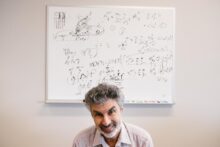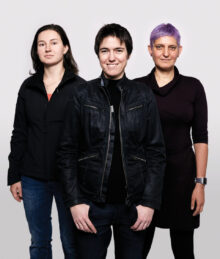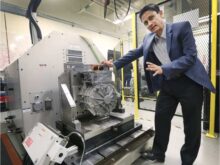Your guide star to innovation
Government of Ontario cuts funding to artificial intelligence institutes; institutes adapt

Yoshua Bengio, an artificial intelligence pioneer and CIFAR fellow, says the institute helped position Canada as an international leader in AI. RENAUD PHILIPPE / NEW YORK TIMES FILE PHOTO
On May 19, The Toronto Star ran a story on the Ford Government’s cutting of $24 million in funding to two research institutes credited with making Canada a global leader in artificial intelligence (AI) research; the Vector Institute for Artificial Intelligence and the Canadian Institute for Advanced Research (CIFAR). The article went on to imply that the cuts will undermine Canada’s competitiveness and hamper efforts to stem the “brain drain” of Canadian tech talent to the US.
However, as the Vector Institute’s CEO, Garth Gibson, stated in an email to its partners (ORION included):
The Toronto Star’s article over the weekend was not news to us. The Vector Institute has a strong and productive working relationship with the Province of Ontario. In Fall 2018, the government amended a $30 million program initially announced in Fall 2017 such that it became a $10 million program and asked the Vector Institute to sharpen the focus of that initiative which is aimed at developing the AI workforce in Ontario.
Thanks to the province’s support, in a December 2018 speech, the Vector Institute’s Chair announced over 60 Vector scholarship winners (more to be announced in the coming weeks) and that there will be net new AI master’s programs created to increase the AI talent pool and labour force attachment in Ontario.
Thus, the Vector Institute will continue to fulfill its core mandate of building Ontario’s (and Canada’s) AI workforce. In addition, increased partnerships with the private sector (as suggested by the Ford government) may compensate for the loss of funding. An example of this would be the March announcement of a $100 million donation from the Gerald Schwartz and Heather Reisman Foundation to the University of Toronto for AI and biomedicine research as well as a new 750,000-square-foot research facility. Provincial AI funding cuts will likely trigger a shift in focus rather than chaos.
Link to Toronto Star article
Uber’s Toronto-based autonomous vehicle AI lab expands, moving to larger building

The all-female senior leadership team: technology program manager Olga Palatnik, chief scientist Raquel Urtasun and senior engineering manager Inmar Givoni. TORONTO LIFE
Uber’s Advanced Technologies Group (UATG), which started in 2015 and is located on the seventh floor of Toronto’s MaRS Centre, is the company’s only research lab outside the U.S. dedicated to building the “brain” for its self-driving fleet. The Toronto UATG lab, which currently employs 60 people (some of Canada’s top AI experts among them) will double in size over the next year, as reported in Toronto Life, requiring a move to a larger building. In addition to the expansion of its research lab, Uber plans to invest another $200 million in a new Toronto engineering hub, which will eventually employ 500 people.
Uber’s innovation and expansion efforts will help solidify Toronto’s status as a global tech hub.
Auto industry investing millions in electric automobile research at the University of Windsor

University of Windsor professor Narayan Kar is shown with an electric vehicle power train testing unit at the Centre for Hybrid Automotive Research and Green Energy (CHARGE) at the school on Friday, May 24, 2019. DAN JANISSE.
As the demand for electric vehicles ramps up, the University of Windsor’s Centre for Hybrid Automotive Research and Green Energy (CHARGE) is helping to keep Canada’s auto sector on the cutting edge.
According to an article in the Windsor Star, CHARGE’s team of 30 researchers, financed by auto industry stalwarts like Ford, D&V Electronics, Magna International and BorgWarne, are experimenting with different materials for use in electric motors, power controls and drive systems. Currently led by Canada’s first Canada Research Chair in Electrified Engineering Systems, CHARGE is looking to add two more research chairs in electric/autonomous vehicles and connected vehicles.
Information and Communications Technology Council releases report examining the need for cybersecurity talent for Canada’s transport infrastructure
Canada’s Information and Communications Technology Council (ICTC) has released its new report ‘Developing Cyber Talent for Canadian Critical Infrastructure – Road Transportation’. The report, funded by Transport Canada, examines the need for cybersecurity talent to safeguard Canada’s future transport infrastructure such as autonomous vehicles and smart cities.
University of California San Francisco (UCSF) team uses machine learning to generate synthetic speech from brain recordings
 A brain-machine interface developed by UCSF neuroscientists can generate natural-sounding synthetic speech by using brain activity to control a software-based ‘virtual vocal tract.’
A brain-machine interface developed by UCSF neuroscientists can generate natural-sounding synthetic speech by using brain activity to control a software-based ‘virtual vocal tract.’
In a study by UCSF, the team mapped areas of the brain that control the movements of the lips, jaw, tongue, and other vocal tract components to produce speech. They then asked five volunteers (epilepsy patients with electrodes temporarily implanted in their brains) to read several hundred sentences out loud while the researchers recorded activity from a brain region known to be involved in language production. The researchers then used linguistic principles to reverse engineer the vocal tract movements (lips, tongue, vocal cords, etc.) needed to produce these sounds. This detailed mapping of sound to anatomy enabled the scientists to create a software-based virtual vocal tract for each participant that could be controlled by their brain. This virtual vocal tract consists of two ‘neural network’ machine learning algorithms: a decoder that transforms speech-related brain activity into movements of the virtual vocal tract, and a synthesizer that converts these movements into a synthetic recreation of the participant’s voice.
The technology may one day be able to restore the power of speech to those who have suffered from a stroke, brain injury, or neurodegenerative diseases such as Parkinson’s disease, multiple sclerosis and amyotrophic lateral sclerosis (ALS, aka Lou Gehrig’s disease).

